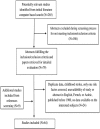The epidemiology of stroke in the Middle East
- PMID: 31008279
- PMCID: PMC6453228
- DOI: 10.1177/2396987316654338
The epidemiology of stroke in the Middle East
Abstract
Purpose: The purpose of this paper is to review and synthesize data from different countries in the Middle East on stroke and its potential risk factors.
Method: A systematic review of all published stroke articles in the Middle East between 1980 and May 2015 was conducted.
Findings: Sixty-four papers were included in the review. The incidence rate for all strokes ranged between 22.7 and 250 per 100,000 population per year. The prevalence rate for stroke ranged between 508 and 777 per 100,000 population. Among studies reporting gender differences, 75% reported a high male-to-female ratio among stroke patients. The mean age of stroke was within the sixth and the seventh decade. Ischemic stroke was the most reported type followed by intracerebral hemorrhage and subarachnoid hemorrhage. Hypertension was the most reported risk factor followed by diabetes. The overall case-fatality rate within one month was 12-32%.
Discussion: During the last decades, there was an increase in stroke incidence and mortality rates in the Middle East. The Middle East faces low rates of self-awareness and control of noncommunicable diseases and also lacks knowledge for stroke risk factors, awareness, causes, and symptoms.
Conclusion: There is an urgent need to develop more efficient and accurate methods to measure stroke in the Middle East. There is also a significant call to increase public awareness and implement interventions on stroke and its risk factors and symptoms to help people understand the negative impact of stroke on quality of life and potentially prevent this disease.
Keywords: Epidemiology; Middle East; stroke/cerebrovascular disease; systematic review.
Conflict of interest statement
The author(s) declared no potential conflicts of interest with respect to the research, authorship, and/or publication of this article.
Figures
Similar articles
-
Pediatric stroke among Hong Kong Chinese subjects.Pediatrics. 2004 Aug;114(2):e206-12. doi: 10.1542/peds.114.2.e206. Pediatrics. 2004. PMID: 15286258
-
Excessive incidence of stroke in Iran: evidence from the Mashhad Stroke Incidence Study (MSIS), a population-based study of stroke in the Middle East.Stroke. 2010 Jan;41(1):e3-e10. doi: 10.1161/STROKEAHA.109.559708. Epub 2009 Nov 19. Stroke. 2010. PMID: 19926844
-
The health loss from ischemic stroke and intracerebral hemorrhage: evidence from the North East Melbourne Stroke Incidence Study (NEMESIS).Health Qual Life Outcomes. 2010 May 14;8:49. doi: 10.1186/1477-7525-8-49. Health Qual Life Outcomes. 2010. PMID: 20470370 Free PMC article.
-
Stroke Epidemiology in South, East, and South-East Asia: A Review.J Stroke. 2017 Sep;19(3):286-294. doi: 10.5853/jos.2017.00234. Epub 2017 Sep 29. J Stroke. 2017. PMID: 29037005 Free PMC article. Review.
-
Acute neurological stroke care in Europe: results of the European Stroke Care Inventory.Eur J Neurol. 2000 Jan;7(1):5-10. doi: 10.1046/j.1468-1331.2000.007001005.x. Eur J Neurol. 2000. PMID: 10809909 Review.
Cited by
-
The budget impact of alteplase in the treatment of acute ischemic stroke in Egypt.Front Neurol. 2023 Nov 8;14:1220615. doi: 10.3389/fneur.2023.1220615. eCollection 2023. Front Neurol. 2023. PMID: 38020606 Free PMC article.
-
Utility of Routine 24-Hour Electrocardiographic Holter Monitoring for Detecting Atrial Fibrillation in Patients Admitted with Acute Stroke Syndromes.Sultan Qaboos Univ Med J. 2025 May 2;25(1):191-199. doi: 10.18295/2075-0528.2824. Sultan Qaboos Univ Med J. 2025. PMID: 40641723 Free PMC article.
-
Length of stay in hospital and rehabilitation centers after stroke in Arab countries and Saudi Arabia: a systematic review and meta-analysis.Ann Saudi Med. 2025 Jul-Aug;45(4):256-269. doi: 10.5144/0256-4947.2025.256. Epub 2025 Aug 7. Ann Saudi Med. 2025. PMID: 40753459 Free PMC article.
-
The burden of stroke and its attributable risk factors in the Middle East and North Africa region, 1990-2019.Sci Rep. 2022 Feb 17;12(1):2700. doi: 10.1038/s41598-022-06418-x. Sci Rep. 2022. PMID: 35177688 Free PMC article.
-
Stroke Prevalence in a Coastal Town on the Black Sea Coast in Turkey: Community Based Study.Neurol Res Int. 2018 Jul 2;2018:8246123. doi: 10.1155/2018/8246123. eCollection 2018. Neurol Res Int. 2018. PMID: 30057814 Free PMC article.
References
-
- Menken M, Munsat TL, Toole JF. The global burden of disease study: implications for neurology. Arch Neurol 2000; 57: 418–420. - PubMed
-
- Tran J, Mirzaei M, Anderson L, et al. The epidemiology of stroke in the Middle East and North Africa. J Neurol Sci 2010; 295: 38–40. - PubMed
-
- Boutayeb A, Derouich M, Boutayeb W, et al. Cerebrovascular diseases and associated risk factors in WHO Eastern Mediterranean countries. Cardiol Angiol 2014; 2: 62–75.
Publication types
LinkOut - more resources
Full Text Sources
Miscellaneous



